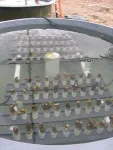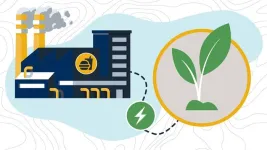(Press-News.org) The lithium-ion batteries used to power electric vehicles are key to a clean energy economy. But their electrodes are usually made using a wet slurry with toxic solvents, an expensive manufacturing approach that poses health and environmental risks.
Early experiments at the Department of Energy’s Oak Ridge National Laboratory have revealed significant benefits to a dry battery manufacturing process. This eliminates the solvent while showing promise for delivering a battery that is durable, less weighed down by inactive elements and able to maintain high energy storage capacity after use. Such improvements could boost wider EV adoption, helping to reduce carbon emissions and achieve U.S. climate goals.
Dry processing is a relatively new alternative that saves factory floor space as well as time, energy, waste disposal and startup expenses, yet until now, researchers have had limited understanding of how and why it works.
ORNL and industry partner Navitas Systems probed how the dry process affects the structure of battery materials and their electrochemical properties. Batteries generate energy as lithium ions travel between electrodes called the cathode and anode. The team focused on an electrode dry processing strategy, which involves mixing dry powders with a binder, then compacting the material to improve contact between the particles. This strategy could be applied to both the anode and cathode by focusing on either certain materials or mixing methods.
After Navitas made the electrodes, ORNL researchers led by Jianlin Li and Runming Tao measured their electrochemical performance in different conditions over various time frames. The ORNL team was able to reach a new understanding of how the dry-processed electrodes degrade.
The batteries made using the dry process showed a “superb” ability to maintain their capacity after extended use, according to results reported in Chemical Engineering Journal. They are “highly chemically desirable” because their structure allows lithium ions to take a more direct path between the anode and cathode, researchers found. The electrodes are thicker to allow higher energy loading while reducing inactive ingredients that increase size and weight.
“There are more active materials in the electrode,” Tao said. “And even after cycling, it will have few cracks.” These two advantages reflect a high energy density and good long-term cyclability. The electrode can bend and flex well, demonstrating excellent mechanical strength and the winding capability needed for mass production of batteries.
The dry process could offer a variety of benefits to manufacturers and the U.S. supply chain: It’s highly compatible with current state-of-the-art electrode manufacturing equipment, while its reduced environmental impact makes battery plants suitable in more places.
“When you’re looking at the gigascale factories, you’re looking at billions of dollars in order to scale batteries up,” said Bryan Steinhoff, technical lead and lead researcher on the project for Navitas. “Dry processing can eliminate the coating and solvent equipment currently necessary for large-scale battery production. If you can use a dry process instead, you can reduce your footprint by up to 40 or 50%, saving hundreds of millions of dollars and starting to enable the creation of an infrastructure to replace one that is largely dependent on Asia at the moment.”
The next step in the research is stabilizing the material that attaches the anode components to a thin metal current collector. “A main goal for this project is to develop or identify a better binder for the dry process, because the current binder is not very stable for the anode environment,” Li said. The team is also working on reducing the amount of carbon black, a material that maintains battery conductivity but detracts from its energy density.
ORNL and Navitas researchers continue to refine the process to improve electrochemical performance. The goal is to balance the benefits and drawbacks of the thicker electrode: It has the potential for higher energy loading and is easy to roll, but it may provide less power, since the ions have further to travel.
The research was sponsored by the DOE Advanced Materials and Manufacturing Technologies Office and conducted at DOE’s Battery Manufacturing Facility, the country’s largest open-access battery research and development center. Some material characterization was conducted at ORNL’s Center for Nanophase Materials Sciences, a DOE Office of Science user facility.
UT-Battelle manages ORNL for the Department of Energy’s Office of Science, the single largest supporter of basic research in the physical sciences in the United States. The Office of Science is working to address some of the most pressing challenges of our time. For more information, please visit energy.gov/science.
The lithium-ion batteries used to power electric vehicles are key to a clean energy economy. But their electrodes are usually made using a wet slurry with toxic solvents, an expensive manufacturing approach that poses health and environmental risks.
Early experiments at the Department of Energy’s Oak Ridge National Laboratory have revealed significant benefits to a dry battery manufacturing process. This eliminates the solvent while showing promise for delivering a battery that is durable, less weighed down by inactive elements and able to maintain high energy storage capacity after use. Such improvements could boost wider EV adoption, helping to reduce carbon emissions and achieve U.S. climate goals.
Dry processing is a relatively new alternative that saves factory floor space as well as time, energy, waste disposal and startup expenses, yet until now, researchers have had limited understanding of how and why it works.
ORNL and industry partner Navitas Systems probed how the dry process affects the structure of battery materials and their electrochemical properties. Batteries generate energy as lithium ions travel between electrodes called the cathode and anode. The team focused on an electrode dry processing strategy, which involves mixing dry powders with a binder, then compacting the material to improve contact between the particles. This strategy could be applied to both the anode and cathode by focusing on either certain materials or mixing methods.
After Navitas made the electrodes, ORNL researchers led by Jianlin Li and Runming Tao measured their electrochemical performance in different conditions over various time frames. The ORNL team was able to reach a new understanding of how the dry-processed electrodes degrade.
The batteries made using the dry process showed a “superb” ability to maintain their capacity after extended use, according to results reported in Chemical Engineering Journal. They are “highly chemically desirable” because their structure allows lithium ions to take a more direct path between the anode and cathode, researchers found. The electrodes are thicker to allow higher energy loading while reducing inactive ingredients that increase size and weight.
“There are more active materials in the electrode,” Tao said. “And even after cycling, it will have few cracks.” These two advantages reflect a high energy density and good long-term cyclability. The electrode can bend and flex well, demonstrating excellent mechanical strength and the winding capability needed for mass production of batteries.
The dry process could offer a variety of benefits to manufacturers and the U.S. supply chain: It’s highly compatible with current state-of-the-art electrode manufacturing equipment, while its reduced environmental impact makes battery plants suitable in more places.
“When you’re looking at the gigascale factories, you’re looking at billions of dollars in order to scale batteries up,” said Bryan Steinhoff, technical lead and lead researcher on the project for Navitas. “Dry processing can eliminate the coating and solvent equipment currently necessary for large-scale battery production. If you can use a dry process instead, you can reduce your footprint by up to 40 or 50%, saving hundreds of millions of dollars and starting to enable the creation of an infrastructure to replace one that is largely dependent on Asia at the moment.”
The next step in the research is stabilizing the material that attaches the anode components to a thin metal current collector. “A main goal for this project is to develop or identify a better binder for the dry process, because the current binder is not very stable for the anode environment,” Li said. The team is also working on reducing the amount of carbon black, a material that maintains battery conductivity but detracts from its energy density.
ORNL and Navitas researchers continue to refine the process to improve electrochemical performance. The goal is to balance the benefits and drawbacks of the thicker electrode: It has the potential for higher energy loading and is easy to roll, but it may provide less power, since the ions have further to travel.
The research was sponsored by the DOE Advanced Materials and Manufacturing Technologies Office and conducted at DOE’s Battery Manufacturing Facility, the country’s largest open-access battery research and development center. Some material characterization was conducted at ORNL’s Center for Nanophase Materials Sciences, a DOE Office of Science user facility.
UT-Battelle manages ORNL for the Department of Energy’s Office of Science, the single largest supporter of basic research in the physical sciences in the United States. The Office of Science is working to address some of the most pressing challenges of our time. For more information, please visit energy.gov/science.
END
Dry manufacturing process offers path to cleaner, more affordable high-energy EV batteries
2023-07-18
ELSE PRESS RELEASES FROM THIS DATE:
UCLA biobank study reveals disease risk, heath care use among LA’s diverse population
2023-07-18
A new study of UCLA Health’s large genetic biobank is giving researchers new insights into the disease risks faced by the region’s diverse communities and their access to health care. The effort, published in Nature Medicine, may prove useful in developing personalized medicine and treatment approaches to groups often overlooked by the medical system.
UCLA Health researchers identified 376 population clusters based on shared genetic ancestry by leveraging information from nearly 36,000 patients enrolled in the UCLA ATLAS Precision Health Biobank. The ATLAS ...
Researchers achieve historic milestone in energy capacity of supercapacitors
2023-07-18
EL PASO, Texas (July 18, 2023) – In a new landmark chemistry study, researchers describe how they have achieved the highest level of energy storage — also known as capacitance — in a supercapacitor ever recorded.
The study, led by Luis Echegoyen, Ph.D., professor emeritus at The University of Texas at El Paso, and Marta Plonska-Brzezinska, Ph.D., of the Medical University of Bialystok, Poland, was recently featured in the journal Scientific Reports, which is published by leading research publisher Nature Portfolios.
Supercapacitors ...
WVU researchers develop hydrogen technology to curtail greenhouse gases from food, beverage industry
2023-07-18
Engineers and scientists at West Virginia University are developing an advanced hydrogen flexible boiler to help decarbonize the food and beverage industry and eventually eliminate greenhouse gas emissions.
The technology, proposed by Hailin Li, professor in the Department of Mechanical and Aerospace Engineering at the WVU Benjamin M. Statler College of Engineering and Mineral Resources, will supply thermal energy by burning clean fuel rather than traditional fossil fuels. Researchers will also work with Morgantown businesses ...
Study offers guidance for improving access to oncology drug treatments in sub-Saharan Africa
2023-07-18
With cancer rates rising throughout sub-Saharan Africa – home to 1.1 billion people, or about 14 percent of the world’s population – researchers with the Botswana-Rutgers Partnership for Health are seeking solutions.
Cancer is among the top three causes of premature death in the vast majority of nations in the region. Without significant interventions, predictions indicate the number of cancer deaths per year in this region would nearly double by 2030, to about 1 million.
In a study published in PLOS Global Public Health, researchers associated with the partnership address the need to improve access to oncology drugs in sub-Saharan Africa, ...
Hidden cameras spot wildlife returning home after 2018 megafire
2023-07-18
Berkeley — During the summer of 2018, the Mendocino Complex Fire ripped through UC’s Hopland Research and Extension Center (HREC), transforming the Northern California property’s grassy, oak-dotted hillsides into a smoldering, ash-covered wasteland.
“It felt like something out of the Lord of the Rings — like Mordor. It was hard to imagine much surviving,” said Justin Brashares, a professor of environmental science, policy and management at the University of California, Berkeley.
But mere months after the fire, animals like coyote, gray foxes and black-tailed jackrabbits were seen returning to the area, spotted by grid of motion-sensor camera traps that ...
What motivates family forest landowners to manage invasive species?
2023-07-18
URBANA, Ill. — Over half of forests in the United States are privately owned, especially in the Eastern part of the country. This can make control of invasive species challenging, as efforts need to be coordinated among many different landowners. A new study from the University of Illinois Urbana-Champaign looks at how family forest landowners in Maine and New Hampshire approach invasive species management and what factors influence their decisions.
“We have mostly public land on the West Coast and privately owned family forestland in the Midwest ...
Lehigh University Professor Dan M. Frangopol elected into Academy of Engineering of Mexico
2023-07-18
Dan M. Frangopol, the inaugural Fazlur R. Khan Endowed Chair of Structural Engineering and Architecture at Lehigh University, has been elected into the Academy of Engineering of Mexico (AEM) as a Corresponding Member.
According to AEM, the academy was “established to recognize the most accomplished and prominent engineers in Mexico,” and it “selects a number of internationally recognized individuals from around the world with outstanding contributions to engineering following a rigorous nomination and evaluation process.”
An induction ...
UC Berkeley study reveals goal-oriented rewards as key factors in decision-making
2023-07-18
Groundbreaking research from UC Berkeley’s Department of Psychology is shifting the understanding of human decision-making processes by highlighting the importance of goal-oriented rewards. Conducted by Berkeley Psychology Professor Anne Collins and Berkeley Psychology doctoral student Gaia Molinaro, the study suggests that the value people attribute to outcomes is subjective, and heavily influenced by their personal goals and the context of the decision.
"Value isn't just determined by an objective reward or outcome,” Collins said. “Our research suggests that people's perception of value is largely shaped by their personal goals and ...
Virtual rehabilitation program for seniors with frailty shows promise, according to McMaster-led research
2023-07-18
Virtually delivered rehabilitation for seniors living with frailty is a feasible way for delivering care, shows new research led by researchers from McMaster University and the Geras Centre for Aging Research.
The study, published in Pilot and Feasibility Studies on July 17, defined frailty, a consequence of aging, as a decline in function and physiological reserve in multiple bodily systems.
Frailty impacts approximately 1.5 million older adults in Canada, and frail seniors account for a large proportion ...
Safe train transport
2023-07-18
Oak Ridge National Laboratory researchers used images from a photo-sharing website to identify crude oil train routes across the nation to provide data that could help transportation planners better understand regional impacts.
More than 300 crude oil rail incidents have occurred in the U.S. over the past decade, causing adverse consequences from fire and hazardous materials leakage. However, only limited information on the transport routes has been publicly available.
In a study, ORNL researchers used geotagged online photos from Flickr to reconstruct transport paths. By linking geotagged crude oil train images with national railway networks, the team ...








